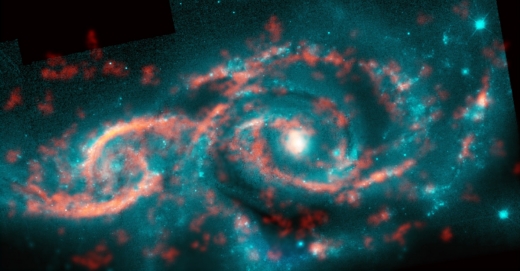Sometimes deep sky objects are so striking that I have no choice but to write about them, even if they weren’t on the agenda for today. 114 million light years from Earth in the direction of Canis Major we see an interacting pair of galaxies. Michele Kaufman (Ohio State University) and colleagues have found arcs of star formation here that give the visual impression of eyelids. They’re evidence of an encounter between the two galaxies, one brought into vivid focus by the Atacama Large Millimeter/submillimeter Array (ALMA).

Image: Dazzling eyelid-like features bursting with stars in galaxy IC 2163 formed from a tsunami of stars and gas triggered by a glancing collision with galaxy NGC 2207 (a portion of its spiral arm is shown on right side of image). ALMA image of carbon monoxide (orange), which revealed motion of the gas in these features, is shown on top of Hubble image (blue) of the galaxy. Credit: M. Kaufman; B. Saxton (NRAO/AUI/NSF); ALMA (ESO/NAOJ/NRAO); NASA/ESA Hubble Space Telescope.
We have no head-on collision here, but by studying the motion of carbon monoxide gas in the ‘eyelid’ features, the astronomers can determine that two galaxies have merely brushed past each other, with the star arcs blooming in the galaxy IC 2163 after its encounter with galaxy NGC 2207. The gas in the outer part of the IC 2163 ‘eyelid’ is moving inward at over 100 kilometers per second, but deceleration is rapid and the gas eventually aligns with the rotation of the galaxy. The close pass that drew out these waves of material is thought to be the first encounter in what will eventually become a merger of the two galaxies.
The imagery prompts Bruce Elmegreen (IBM Watson Research Center, Yorktown Heights NY), one of the paper’s co-authors, to compare the waves of star formation to massive ocean waves moving in toward shore that stay more or less intact until they hit shallow water, when they lose their momentum and pour onto the beach. The ocular look of the encounter is striking but not completely uncommon, with other examples of eye-like structures having been identified with much the same causes. Michele Kaufman comments on the process:
“Not only do we find a rapid deceleration of the gas as it moves from the outer to the inner edge of the eyelids, but we also measure that the more rapidly it decelerates, the denser the molecular gas becomes. This direct measurement of compression shows how the encounter between the two galaxies drives gas to pile up, spawn new star clusters and form these dazzling eyelid features.”

Image: Galaxies IC 2163 (left) and NGC 2207 (right) recently grazed past each other, triggering a tsunami of stars and gas in IC 2163 and producing the dazzling eyelid-like features there. Here we can see both galaxies. As in the image above, the ALMA image of carbon monoxide (orange), which revealed motion of the gas in these features, is shown on top of the Hubble image (blue) of the galaxy pair. Credit: M. Kaufman; B. Saxton (NRAO/AUI/NSF); ALMA (ESO/NAOJ/NRAO); NASA/ESA Hubble Space Telescope.
The ocular structure develops in simulations of galaxy encounters and has been studied since the early 1990s, when it became clear that a close encounter with a galaxy of similar mass causes a disk galaxy to develop two long tidal arms. The resulting ocular structure lasts only a few tens of millions of years, making finding a newly formed example a rarity.
Observing galaxy pairs like this gives us a chance to test the physics we have been modeling for years. In the excerpt from the paper that follows, both N-body simulations (simulations of the dynamics of particles under forces like gravity) and SPH, or Smoothed-particle Hydrodynamic simulations (simulating liquid flows) are brought to bear on the question:
In the encounter simulations, IC 2163 suffers a prograde, nearly in-plane encounter as it passes, mainly southward, behind NGC 2207 (relative to us), and its ocular structure forms from outer disk material that loses angular momentum in the tidal perturbation, flows inward until it hits an angular momentum barrier, piles up in the eyelids, and produces a shock zone there. Although in the SPH model by Struck et al. (2005), the outer disk of IC 2163 initially side-swipes the outer disk of NGC 2207, the ocular shock zone is not the result of direct contact between the two galaxies but develops later from the prolonged prograde encounter.
What we learn from the ALMA work is that the observed velocities of the molecular gas in the eyelid features line up with the predictions of computer models, a key test for their evaluation. “This evidence for a strong shock in the eyelids is terrific,” says Curtis Struck (Iowa State University), one of the paper’s co-authors. “It’s all very well to have a theory and simulations suggesting it should be true, but real observational evidence is great.”
The paper is Kaufman et al., “Ocular Shock Front in the Colliding Galaxy IC 2163,” accepted at the Astrophysical Journal (preprint).



Our coming collision will be more dramatic than this galactic drive-by. In fact, our solar system will outlive our galaxy:
http://phenomena.nationalgeographic.com/2014/03/24/scientists-predict-our-galaxys-death/
No need to worry, just passing through I guess.
I try not to post off-topic items too much here, but this is very interesting. NASA and FEMA are getting together for asteroid impact planning:
http://phys.org/news/2016-11-nasa-fema-asteroid-emergency.html